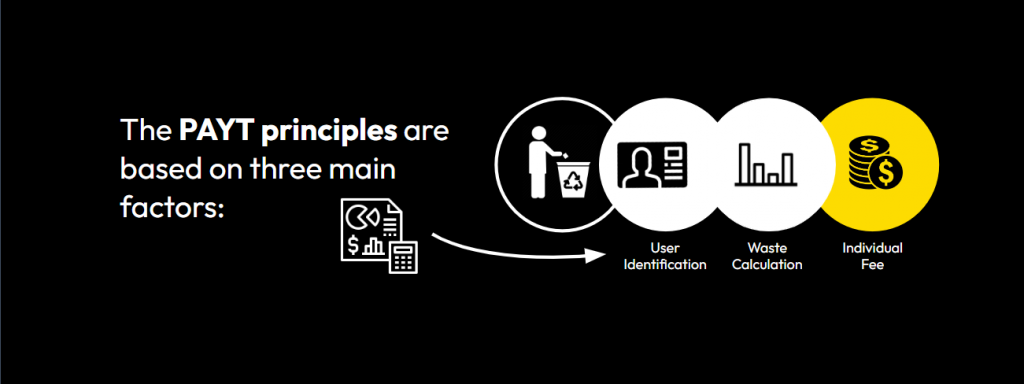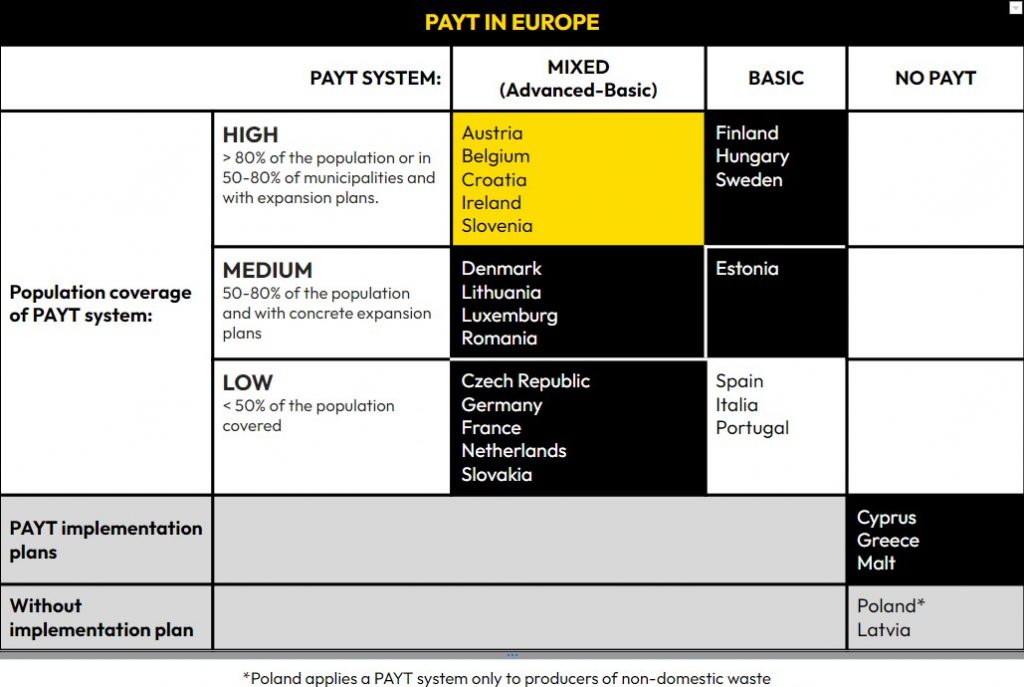
Waste management is a global challenge that requires innovative solutions to improve its efficiency and contribute to the achievement of the reuse and recycling targets set by the European Commission. In order to encourage the application of the waste hierarchy, the concept of Pay As You Throw (PAYT) has emerged. A model that allows the establishment of an individual waste fee that varies according to the actual waste generation. In this article, we will explore what the Pay as you Throw consists of, its advantages and how it can encourage more environmentally friendly waste management.
¿What is Pay As You Throw?
Pay As You Throw (PAYT) is an economic instrument that applies the “polluter pays” principle when setting a waste fee. Instead of setting a fixed rate for all users, the PAYT is based on the measurement of the waste generated by each individual, in order to apply a specific rate.
This measurement can be done on the basis of volume, weight, or number of waste contributions. With this information, the final amount of the waste fee is determined, allowing to combine, depending on the needs, a variable part to a fixed fee. In this way, the behavior of waste generators is incorporated into the calculation of the fee, taxing the least environmentally friendly behavior, and applying what is known as a “fair fee”.
Most of the time, PAYT systems are applied according to the use of the residual fraction, promoting more sustainable practices, such as reuse, waste reduction or recycling. In addition, this scheme can be combined with bonus and incentive models, known as “Reward As You Throw” (RAYT).
The PAYT principles are based on three main factors:
- User identification: To be able to measure the contribution of each citizen, the first step is to identify the waste generator. Depending on the collection model (use of ordinary bins on the street or door-to-door collection), the use of smart bins equipped with an access control system is required. In door-to-door collection models, the user is identified when delivering the waste; however, there are also technological solutions to identify the bins or bags provided by the citizen.
- Calculation of waste produced: This step can be carried out according to the volume of contributions made or by means of weighing systems (located in the bin itself or in the collection vehicle).
- Specific fee: Individualized charge based on the waste generated and the selective sorting carried out at the origin.

Figure 1: PAYT principles scheme
Implementation cases in Europe:
Most EU Member States already have some form of PAYT system in place for at least part of the population. Currently, examples can be found in 20 member states of the EU, although only in Austria, Slovenia, Finland and Ireland PAYT is applied across all municipalities.
PAYT systems are designed in many different ways. Depending on the economic incentive applied, we can distinguish between:
- Advanced PAYT: They offer a direct and visible financial incentive at the time the waste is generated. For example, by weighing containers during collection and charging according to the kg of waste generated. Another interesting approach includes systems based on the purchase of garbage bags directly from local authorities.
It is important to note that no Member State relies exclusively on these advanced PAYT systems, as they coexist with other more basic options. - Basic PAYT: These systems, for example, are based on waste volume and rely mainly on the size of the containers. In some cases, they may also consider collection frequency when determining rates. In this type of PAYT, households can customize the number and size of containers when setting up the waste collection service.
In the table below, we see an outline of the PAYT systems applied in the Member States:

Figure 2: Summary of PAYT type and population coverage in Europe
Is worth noting the top five countries with the highest recycling rates apply a mixed PAYT system, either in a strong (green) or medium-level design of the instrument. Here more details about the color codes in Figure 3 can be found.

Figure 3: Top 5 countries with the highest recycling rates and PAYT coverage
Advantages of Pay As You Throw:
Pay as you Throw offers several significant advantages over traditional fixed-rate systems.
Some of the main advantages are:
- Waste reduction: By economically penalizing the generation of waste, citizens are incentivized to reduce their waste production and adopt more environmentally responsible habits.
- Increase of recycling: In this type of scheme, the use of selective collection bins is not penalized (it is free), encouraging the use of sorting at origin among citizens and increasing the recycling rate.
- Calculation of a fair fee: With PAYT, each user pays according to their actual waste generation, ensuring a fairer distribution of costs in municipal waste management.
- Waste traceability: The implementation of PAYT implies greater control in the waste value chain, from the origin to its final destination, improving the traceability of the waste services.
- Citizen awareness: By making citizens aware of the real cost of their waste generation and the impact of their consumption habits, environmental awareness is increased among the population.
Candam Technologies Solution:
In this context, Candam Tech presents itself as a strategic ally for local entities, providing different technological solutions for the implementation of new waste management schemes such as Pay as you Throw (PAYT) or Reward Systems (RAYT) to improve recycling rates.
The Recysmart device, with Candam’s patented technology, allows you to set up different recycling schemes in an easy and affordable way.
In addition, we have a technical team of experts to advise local authorities and regional organizations in updating their waste fees, ensuring the implementation of a fair and non-deficient fee, that complies with the requirements of the new legislation.
Do you want to know how we can help you?
If you need more information contact us
References
Eurostat (2023), “Municipal waste by waste management operations“.
EEA (2023), “Economic instruments and separate collection systems – key strategies to increase recycling”.
EEA and ETC CE (2022), “early warning assessments related to the 2025 targets for municipal waste and packaging waste”.
Gobierno de España. (2022). Ley 7/2022 de residuos y suelos contaminados. BOE núm. 50, de 25 de febrero de 2022, pp. 21064-21097.
Fundació ENT (2022). La Evolución de las Tasas de Residuos en España, 2015-2022.
Fundació ENT (20219). “Identificación de los usuarios en la recogida de residuos municipales en contextos con alta densidad de población”.
ACR+ (2019). “135 paper and packaging Waste collection systems”.
Agència de Residus de Catalunya, ARC (2016). Cross-analysis of ‘Pay-As-You-Throw’ schemes in selected EU municipalities.
Reichenbach, J. (2008). Status and prospects of pay-as-you-throw in Europe – A review of pilot research and implementation studies. Waste Management, 28, 2809-2814.
 English
English  Español
Español  Português
Português  Polski
Polski 





 by
by 